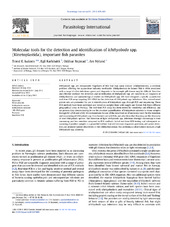| dc.contributor.author | Isaksen, Trond Einar | eng |
| dc.contributor.author | Karlsbakk, Egil | eng |
| dc.contributor.author | Repstad, Oddvar | eng |
| dc.contributor.author | Nylund, Are | eng |
| dc.date.accessioned | 2015-04-21T11:51:31Z | |
| dc.date.available | 2015-04-21T11:51:31Z | |
| dc.date.issued | 2012-12 | eng |
| dc.identifier.issn | 1383-5769 | en_US |
| dc.identifier.uri | https://hdl.handle.net/1956/9830 | |
| dc.description.abstract | Ichthyobodo spp. are ectoparasitic flagellates of fish that may cause disease (ichthyobodosis), a common problem affecting the aquaculture industry worldwide. Ichthyobodosis in farmed fish is often associated with a range of other infectious agents and diagnosis in for example gill disease may be difficult. Sensitive and effective methods for detection and identification of Ichthyobodo spp. are needed to aid diagnosis of ichthyobodosis and epizootiological studies on Ichthyobodo spp. We have designed a specific quantitative real-time PCR assay targeting SSU rDNA for the detection of Ichthyobodo spp. infections. Also, several novel primer sets are presented for use in identification of Ichthyobodo spp. through PCR and sequencing. These PCR methods have been optimized and tested on samples from wild caught and farmed fish from different geographical areas in Norway. The real-time PCR assay has been tested for sensitivity and efficiency, and we present data demonstrating its use for absolute quantification of Ichthyobodo salmonis in tissue samples through RT-qPCR and qPCR. We demonstrate the use of the described set of molecular tools for the detection and sequencing of Ichthyobodo spp. from farmed and wild fish, and also show that they may aid the discovery of new Ichthyobodo species. The detection of light Ichthyobodo spp. infections through microscopy is time consuming and less sensitive compared to PCR methods. Initial real-time PCR testing and subsequent sequencing of positive samples is a powerful method that will increase diagnostic precision, aid carrier detection and promote species discoveries in the Ichthyobodonidae. Our preliminary observations indicate a high Ichthyobodo spp. diversity. | en_US |
| dc.language.iso | eng | eng |
| dc.publisher | Elsevier | en_US |
| dc.rights | Attribution-NonCommercial-NoDerivs CC BY-NC-ND | eng |
| dc.rights.uri | http://creativecommons.org/licenses/by-nc-nd/3.0/ | eng |
| dc.subject | Kinetoplastida | eng |
| dc.subject | Ichthyobodo necator | eng |
| dc.subject | Ichthyobodo salmonis | eng |
| dc.subject | 18S rRNA gene | eng |
| dc.subject | Protozoa | eng |
| dc.subject | Real time PCR | eng |
| dc.title | Molecular tools for the detection and identification of Ichthyobodo spp. (Kinetoplastida), important fish parasites | en_US |
| dc.type | Peer reviewed | |
| dc.type | Journal article | |
| dc.date.updated | 2015-04-01T07:16:32Z | en_US |
| dc.description.version | publishedVersion | en_US |
| dc.rights.holder | Copyright 2012 Elsevier Ireland Ltd. | en_US |
| dc.identifier.doi | https://doi.org/10.1016/j.parint.2012.07.006 | |
| dc.identifier.cristin | 978485 | |
| dc.source.journal | Parasitology international | |
| dc.source.40 | 61 | |
| dc.source.14 | 4 | |
| dc.source.pagenumber | 675-683 | |
| dc.subject.nsi | VDP::Mathematics and natural scienses: 400::Zoology and botany: 480::Parasitology: 484 | en_US |
| dc.subject.nsi | VDP::Matematikk og naturvitenskap: 400::Zoologiske og botaniske fag: 480::Parasittologi: 484 | nob |

